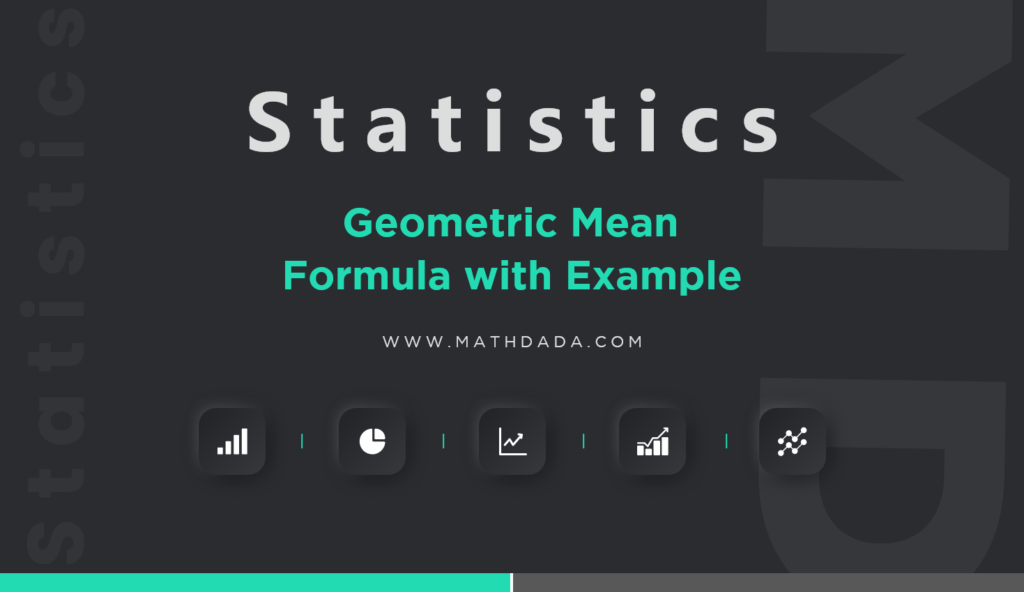Geometric Mean
Here we will learn all the Geometric Mean Formula With Example. The Geometric Mean is nth root of the product of n quantities of the series. It is observed by multiplying the values of items together and extracting the root of the product corresponding to the number of items. Thus, the square root of the products of two items and cube root of the products of the three items are the Geometric Mean.
Usually, GM is never larger than AM. If there are negative numbers and zeros in the series, the GM cannot be used. Logarithms can be used to find GM to reduce the large number and to save time.
The geometric mean (GM) of a series of ‘n’ positive numbers is given by:
1. In case of discrete series without frequency,
\[GM=\sqrt[n]{{{x}_{1}}.{{x}_{2}}…..{{x}_{n}}}\]
It is also given by
\[GM=anti\log (\frac{\sum{\log x}}{n})\]
2. In case of discrete series with frequency,
\[GM=\sqrt[n]{{{x}_{1}}^{{{f}_{1}}}.{{x}_{2}}^{{{f}_{2}}}….{{x}_{n}}^{{{f}_{n}}}}\]
Where,
\[n={{f}_{1}}+{{f}_{2}}+….+{{f}_{n}}\]
It is also given by,
\[GM=anti\log \{\frac{\sum{f\log x}}{n}\}\]
3. In case of continuous series,
\[GM=\sqrt[n]{{{m}_{1}}^{{{f}_{1}}}.{{m}_{2}}^{{{f}_{2}}}….{{m}_{n}}^{{{f}_{n}}}}\]
Where,
\[n={{f}_{1}}+{{f}_{2}}+….+{{f}_{n}}\]
And m1, m2, …, mn are the mid points of class intervals.
It is also given by,
\[GM=anti\log \{\frac{\sum{f\log m}}{n}\}\]
Weighted Geometric Mean
Like the weighted arithmetic mean we can also calculate the weighted geometric mean.
\[{{G}_{W}}=anti\log \{\frac{\sum{W\log x}}{W}\}\]
GW = Weighted Geometric Mean
∑ W log x = Sum of the products of the logarithms of the value x and their corresponding weights.
∑ W = Sum of the weights.
| Example 01 |
Find the Geometric Mean of data 2, 4, 8.
Solution:
Here x1 = 2, x2 = 4, x3 = 8
\[GM=\sqrt[3]{{{x}_{1}}\times {{x}_{2}}\times {{x}_{3}}}\]
\[GM=\sqrt[3]{2\times 4\times 8}=\sqrt[3]{64}=4\]
| Example 02 |
Find the GM of following data.
| Marks(x) | 130 | 135 | 140 | 145 | 150 |
| No. of Students(f) | 3 | 4 | 6 | 6 | 3 |
Solution:
| Marks (x) | No. of Students (f) | log x | f log x |
| 130 | 3 | 2.113 | 6.339 |
| 135 | 4 | 2.130 | 8.520 |
| 140 | 6 | 2.146 | 12.876 |
| 145 | 6 | 2.161 | 12.996 |
| 150 | 3 | 2.176 | 6.528 |
| ∑ f = n = 22 | ∑ f log x = 47.23 |
\[GM=anti\log \{\frac{\sum{f\log x}}{n}\}\]
\[=anti\log \{\frac{47.23}{22}\}=140.212\]
| Example 03 |
Find out GM for given data
| Yield of wheat in MT | 0-10 | 10-20 | 20-30 | 30-40 | 40-50 | 50-60 |
| No. of farms frequency(f) | 3 | 16 | 26 | 31 | 16 | 8 |
Solution:
| Class Interval | Mid-value (m) | No. of farms (f) | log m | f log m |
| 0-10 | 5 | 3 | 0.699 | 2.097 |
| 10-20 | 15 | 16 | 1.176 | 18.816 |
| 20-30 | 25 | 26 | 1.398 | 36.348 |
| 30-40 | 35 | 31 | 1.544 | 47.864 |
| 40-50 | 45 | 16 | 1.653 | 26.448 |
| 50-60 | 55 | 8 | 1.740 | 13.920 |
| ∑ f = n = 100 | ∑ f log m = 145.493 |
\[GM=anti\log \{\frac{\sum{f\log m}}{n}\}\]
\[=anti\log \{\frac{145.493}{100}\}=28.505\]
Arithmetic Mean |
Harmonic Mean |


